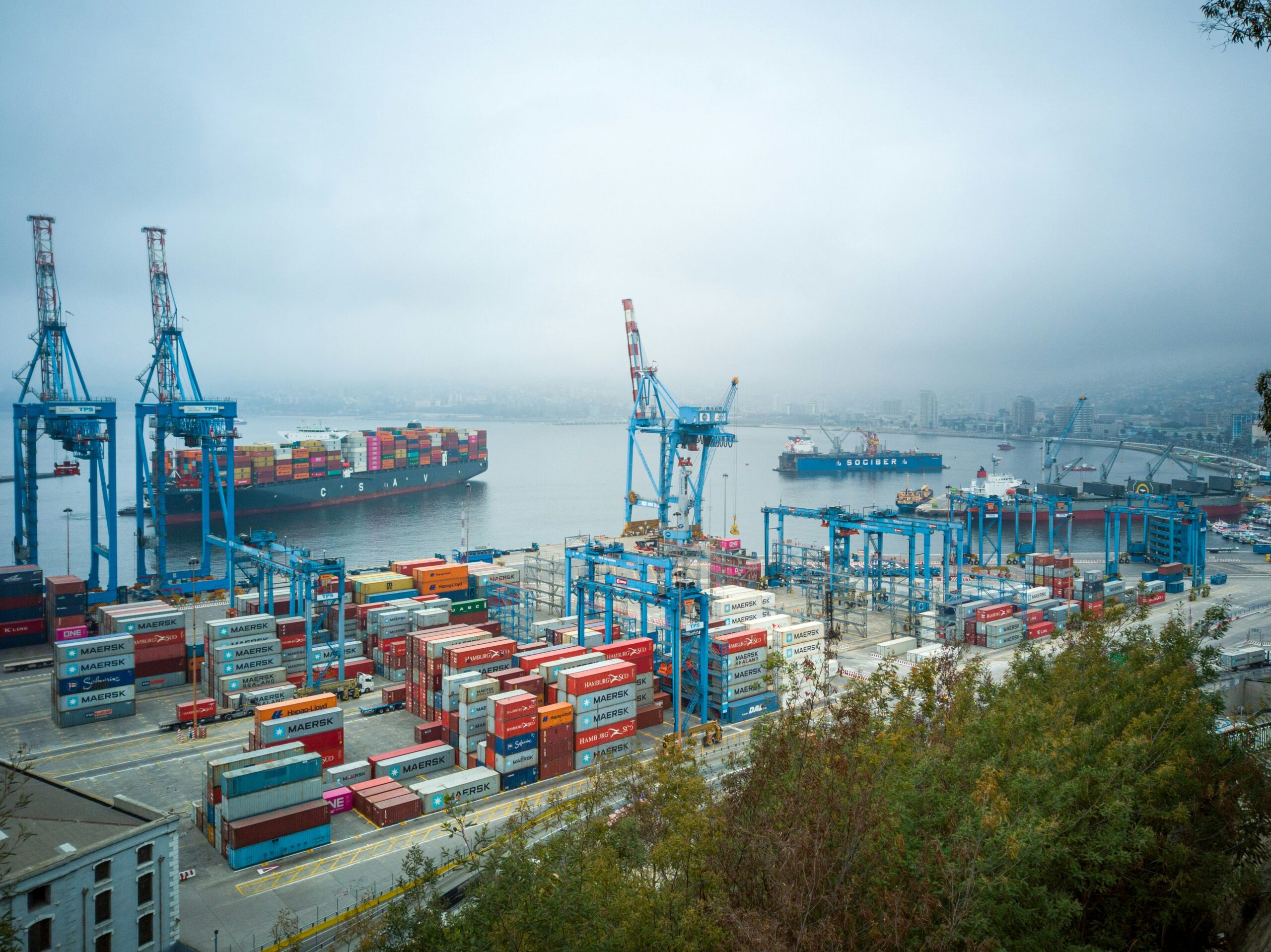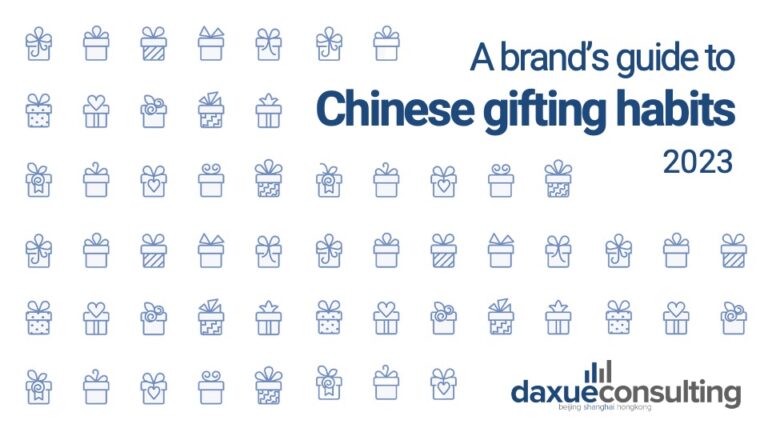In China, the retail distribution market is characterized by a fast-moving ecosystem, composed of a complex network that ties together different market players such as manufacturers, Chinese wholesale suppliers, trading companies, distributors, agents, and retailers. This network presents a landscape filled with untapped opportunities that many foreign companies are eager to discover and leverage for their international expansion.
However, China’s vast domestic market, with its seemingly limitless potential, is also matched by the intensity of competition that engulfs both domestic and international players. The battlefield is fierce, with numerous multinational retailers grappling to carve out their niche, some even retreating in the face of insurmountable challenges. The tale of Tesco’s retreat, explained by its inability to adapt its product ranges to Chinese consumers’ flexible tastes and preferences, underscores the critical necessity for a nuanced localization strategy.
Understanding the intricacies of Chinese distributors’ channels is of paramount importance for foreign businesses aiming to form strategic alliances with local distributors and increasingly tap into this lucrative yet complex market.
Navigating the complexities of the Chinese distributors’ network
According to the Market insights firm Precedence Research, the global industrial distribution sector, valued at USD 7.72 trillion in 2022, is on an upward trajectory with a projected compound annual growth rate (CAGR) of 4.5% from 2023 to 2032. In this expanding landscape, China’s retail market is a standout, estimated at USD 1.94 trillion in 2024. It’s expected to surge to $2.87 trillion by 2029, growing at a robust CAGR of 8.17% during the five years.
Commanding 25% of the global distribution market, China’s retail sector comfortably has the nation’s status as the world’s second-largest retail economy, just behind the United States. This significant market share effectively underscores China’s metamorphosis from a global manufacturing hub to a thriving consumer market, mirroring the government’s strategic pivot towards fostering a domestic-led, high-value-added economic growth model.
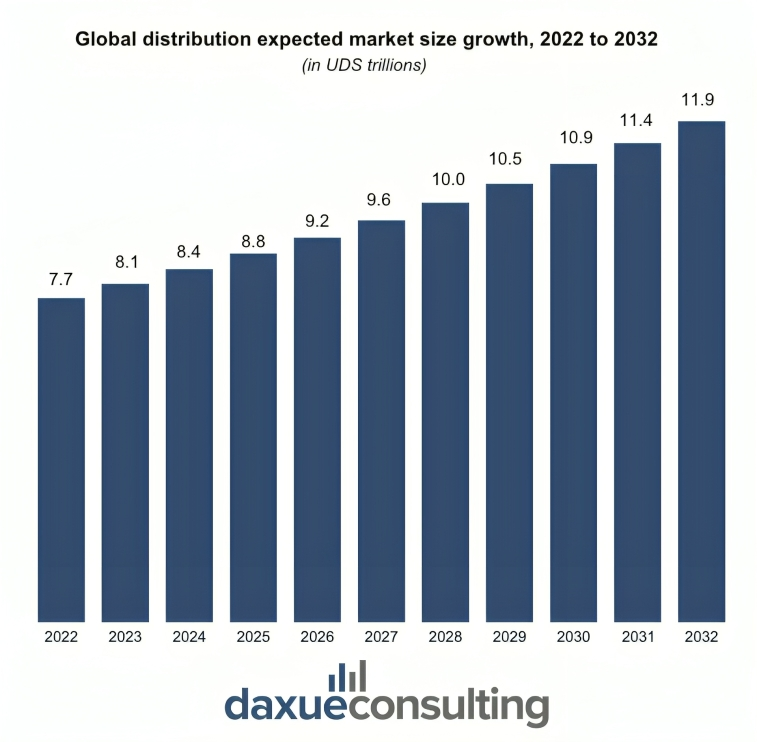
In examining China’s retail distribution market segmentation in 2022, we can see that the sales of the top 10 national retailers alone amassed an impressive $88.4 billion, as reported by the USDA Foreign Agricultural Service. In mid-2022, Walmart and Yonghui led the supermarket segment, each with $14.7 billion in sales. RT Mart was close behind with sales of $14.6 billion.
On the convenience store front, YiJie topped the charts with over 27,000 outlets, indicative of the sector’s adaptation to consumer trends favoring convenience and speed. Walmart, a global name, continues its robust presence with hundreds of outlets, evidencing the competitive nature of China’s retail environment.
Convenience stores, catering to the Chinese consumers’ preference for time and cost savings, have also witnessed burgeoning numbers. YiJie leads this segment with over 27,000 outlets, while 7-Eleven, Lawson and Family Mart stands as the sole international players with a considerable footing in Tier 1 cities.
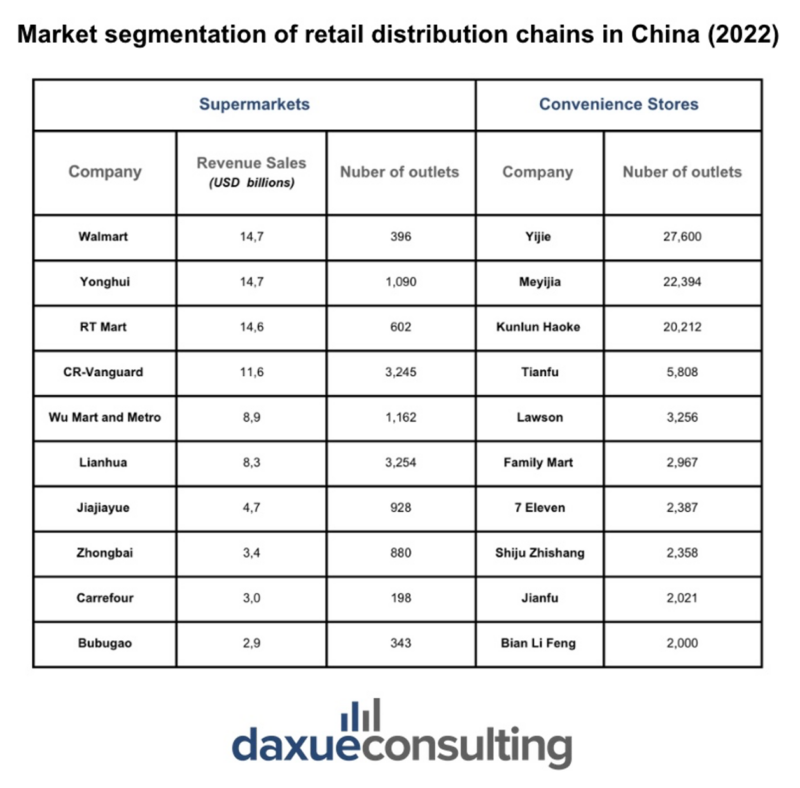
Data Source: China Chain Store & Franchise Association, designed by Daxue Consulting, Market segmentation of retail distribution chains in China (2022)
Unpacking China’s retail distribution network
In China, retail products are being distributed through a diverse networks of stakeholders and Chinese suppliers relying on both traditional and modern style distribution channels.
The backbone of China’s retail distribution network is its advanced logistics and infrastructure. The country has invested heavily in transportation networks, including high-speed rail, highways, and ports, which streamline the movement of goods across vast distances. In the end of 2020, China’s operational train mileage reached 146,000 kilometers, while highways extended to 5.20 million kilometers. This represents an expansion of 7 and 64 times, respectively, compared to the early days. Specifically, expressway mileage in China, which ranks first globally, stood at 161,000 kilometers by the end of 2020.
These existing distribution networks are densely concentrated in major cities such as Shanghai, Beijing, and Guangzhou, which act as pivotal distribution hubs. From these hubs, products are disseminated throughout the country, reaching various consumer bases across a multitude of retail channels.
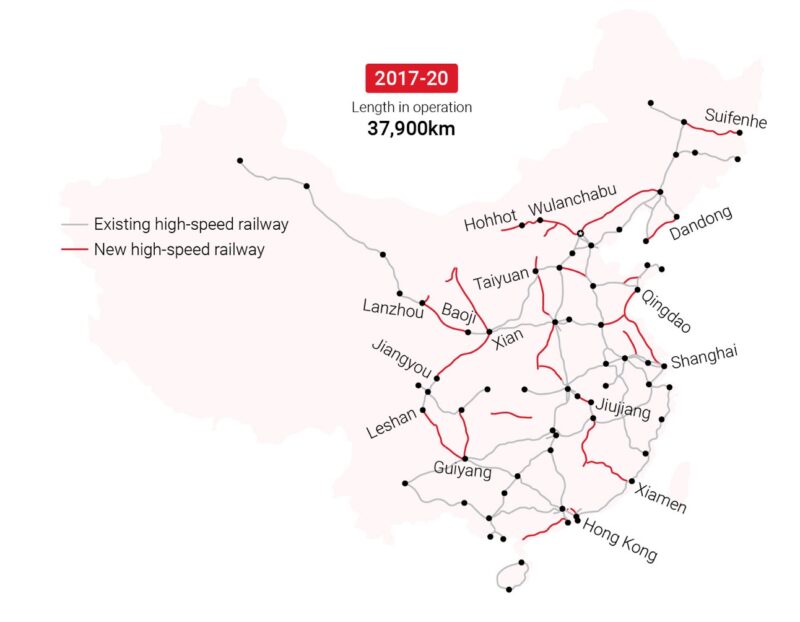
The growth of e-commerce fuels retail distribution in China
The rise of e-commerce platforms has also dramatically transformed the retail distribution landscape in China. Platforms like Alibaba’s Taobao and Tmall, JD.com, and Pinduoduo have become integral to retail distribution, offering a direct-to-consumer model that bypasses traditional layers of distribution. The online retail sector has continuously underscored a reliable increase in its sales revenue reaching 10.8 billion yuan, in 2023 and marking an 11.6% increase year-on-year,
However the usage of these channels varies significantly across China’s different provinces. For instance, urban areas like Beijing or Shanghai report an e-commerce penetration rate of over 70%, whereas rural areas in China’s most western regions like Gansu might lag with rates around 40-50%. This suggests that foreign and Chinese companies aiming to expand their retail distribution network in China must tailor their strategies to accommodate the unique mix of distribution channels that consumers tend to rely to in each province.
Direct sourcing: The golden key for foreign firms?
Navigating the complex terrain of the Chinese retail distribution market often leaves international brands grappling with the dilemma of whether finding a direct Chinese distributor can offer a strategic advantage.
Directly finding a local distributor usually offers numerous benefits, notably in terms of cost savings, access to a broader product range, and the ability to customize products. Direct engagement facilitates clearer communication and quicker resolution of any issues that may arise. However, it necessitates thorough vetting to ensure the Chinese distributors’ reliability and adherence to quality standards.
In the retail environment, the process of acquiring goods from Chinese wholesalers can be considered a critical initial step for foreign companies. This entails a thorough identification of reputable wholesalers, initiating negotiations, and managing logistics effectively. These negotiations cover aspects such as product specifics, pricing, and terms of delivery.
An essential part of this process is ordering samples to ensure the product meets the company’s standards before committing to a larger order. This culminates in the placement of an order and arranging the logistics to ship the products to their intended destination.
Successful navigation of this process involves detailed research to identify Chinese distributors that not only specialize in the required product category but also hold a robust reputation for quality and reliability. Conducting a thorough due diligence is essential in this context, so as to well understand the Chinese distributor’s capabilities, financial stability, market reputation, and logistical efficiency.
International businesses should diligently verify each wholesaler’s references, examine Chinese supplier’ portfolios, and assess if they are aligned with their own business objectives. In addition, the importance of building relationships and trust cannot be overstated. Establishing a strong bond with a reliable distributor through open communication and mutual respect is the best way to pave a long-lasting partnership.
Building bridges: How to connect with China distributors and agents
Establishing a solid presence in China’s retail sector is a multifaceted challenge that foreign companies face, particularly when it comes to finding reliable distributors and agents. Discovering an authorized distributor or agent in China can be approached through multiple sales channels.
Trade shows and Exhibitions
Trade shows are a traditional platform for company’s to efficiently get into contact with their desired partners, distributors included. For example, exhibitions, both within China, like the China International Import Expo (CIIE) in Shangai and internationally, like the Consumer Electronics Show (CES) in Las Vegas, are invaluable for businesses looking to make immediate connections. These events provide a unique opportunity for conducting face-to-face interaction with professionals who likely hold a vested interest in your product category and are certainly open to expanding their business opportunities.
Industry Online Platforms
Industry platforms are also an essential instrument for companies to take into account if they wish to pave a direct path to a wide array of potential partners. Online B2B marketplaces such as Alibaba, Made-in-China.com, and Global Sources serve as digital conduits connecting manufacturers with buyers, distributors, and agents. These platforms allow companies to conduct thorough research on potential partners, view their offerings, their Chinese website information and initiate seamless contacts.
Local Insights
Leveraging local insights can also lead to more nuanced and effective partnerships. Specialized consultancies with a deep understanding of the Chinese market can often offer personalized advice and help in connecting with reputable Chinese distributors and agents. These experts assist with due diligence and negotiations, ensuring that foreign companies understand and navigate the complexities of local business practices effectively.
For instance Consultancies like Dezan Shira & Associates and China Market Research Group (CMR) specialize in crafting tailored market entry process and expansion strategy for foreign firms. On the other hand, other consultancies like BCG’s Digital Ventures and KPMG China offer cultural training and localization services to ensure that products and marketing strategies resonate with Chinese consumers.
The double-edged sword: Weighing the benefits and challenges of partnerships with local distributors
The Strategic benefits of a local partnership
Forging partnerships with local distributors and agents and agents in China unlocks significant strategic benefits for foreign companies. Access to these partners’ vast networks and their deep insights into the local market can be invaluable. They offer an understanding of consumer behavior, market trends, and regulatory nuances, which are crucial for a foreign brand tailoring products and strategies to the Chinese market.
Moreover, leveraging these partnerships can lead to cost savings and more efficient use of resources, as it allows companies to bypass the hefty investments required for setting up their operations, from logistics to team building, thus optimizing their business model for better scalability and flexibility.
Navigating the inherent challenges
On the flip side, collaboration with local intermediaries in China are not always the best option as they also pose certain challenges. The delegation of marketing and distribution to third parties can sometimes dilute a brand’s control over its messaging and standards, requiring a strong foundation of trust and clear communication to maintain brand integrity.
Additionally, profit-sharing with these partners, while standard, necessitates careful negotiation to ensure that the terms remain favourable, safeguarding the financial health of the business. Navigating these challenges is essential for sustaining a profitable and harmonious partnership that supports long-term success in China’s retail distribution landscape.
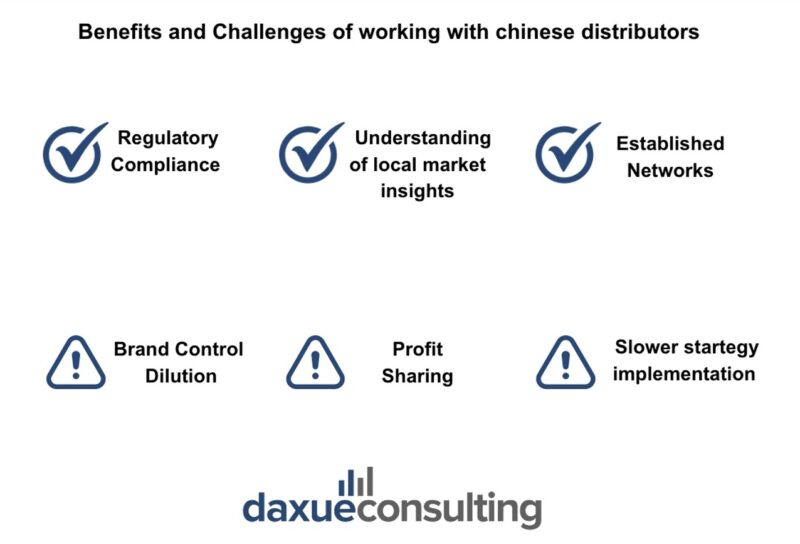
Decoding the partnership puzzle: Tailoring your strategy for the Chinese market
Strategy and control
The strategy and control over one’s brand and product distribution play a pivotal role in the decision-making process between opting for distributors or agents. Companies aiming for rapid market penetration and broad coverage might lean towards distributors in China known for their extensive networks, despite the trade-off of having less direct control over brand management.
Conversely, businesses that place a high value on brand consistency and nurturing customer relationships might prefer the more hands-on approach that agents or collaborative China distributors offer. The complexity of the product and the level of after-sales support it requires also influence this choice, with agents or specialized distributors becoming indispensable for products that demand detailed explanations or extensive customer support.
Operational fit and flexibility
On the operational side of the spectrum, the choice between distributors and agents is often influenced by the company’s resource allocation and its need for flexibility in response to Chinese market changes. For firms with limited resources, agents present a less financially burdensome path as they typically do not require the significant upfront investment associated with the direct market presence required when establishing a network of distributors in China.
Furthermore, the dynamic nature of the market means that adaptability is key; agents provide the agility to modify strategies or adjust pricing swiftly, offering a strategic advantage to businesses in rapidly changing environments. In contrast, while distributors may offer a broader market reach and help with Chinese language barriers, they often cannot match the speed of response that agents can, making the latter a preferable option for companies that value flexibility.
Cross-border commerce: Navigating through China’s international agreements
Free Trade Agreements (FTAs)
China has signed numerous FTAs that reduce tariffs, import quotas, and export restraints with trading partners. These agreements enhance market access for goods and services, including retail products, making it easier and more cost-effective for foreign companies to distribute products in China and vice versa. Examples include the China-Australia Free Trade Agreement (ChAFTA) and the China-South Korea FTA.
E-Commerce Agreements
To bolster cross-border e-commerce, China has established specific agreements focusing on the digital trade environment. These agreements often include provisions on data protection, digital customs, and consumer rights, aiming to create a supportive ecosystem for online retail operations. The Electronic Commerce Cooperation Framework Agreement between China and ASEAN countries is an example, designed to facilitate e-commerce development.
Regional Comprehensive Economic Partnership (RCEP)
The RCEP is a free trade agreement between the Asia-Pacific nations, including China, ten ASEAN countries, and five of their FTA partners (Australia, Japan, New Zealand, South Korea, and India initially, though India has since opted out of signing). It aims to lower tariffs and open up service sectors within the bloc, creating new opportunities for retail distribution by simplifying customs procedures and boosting market access across the region.
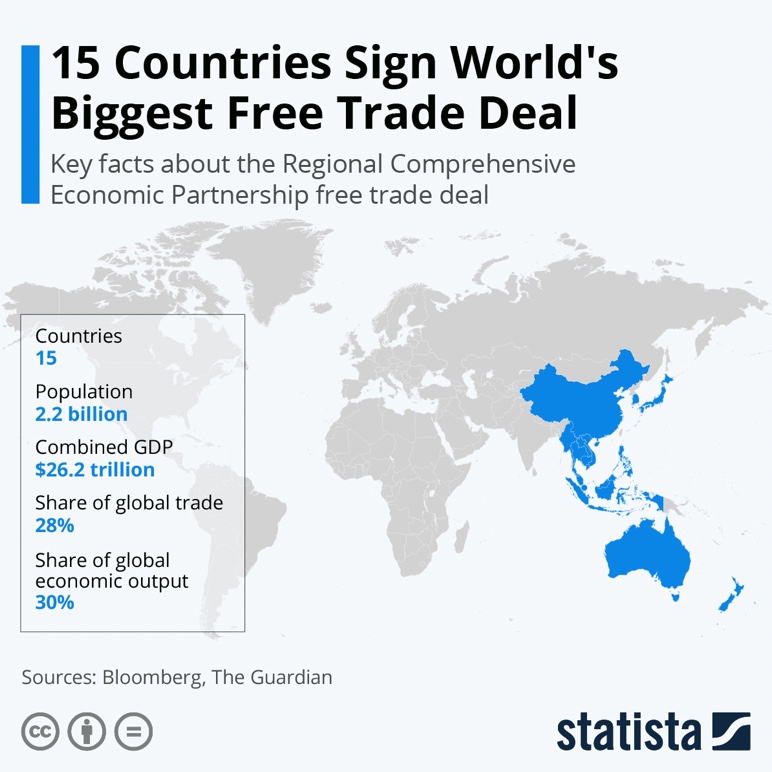
Conclusive thoughts: How to build lasting partnerships with distributors in China
- China’s retail market, second only to the U.S., is a major global player, offering significant opportunities for foreign firms willing to navigate its complex distribution networks.
- The country’s advanced logistics and infrastructure, including the world’s leading expressway mileage, support an efficient distribution system, especially in major cities.
- E-commerce has transformed retail distribution, with platforms like Alibaba and JD.com leading the way, though penetration rates vary significantly across provinces.
- Direct sourcing and engaging with local distributors and agents are key strategies for foreign firms entering the Chinese market, each offering unique advantages and challenges.
- China’s participation in international agreements and FTAs, such as RCEP, facilitates retail distribution by reducing trade barriers and promoting cross-border e-commerce.
Daxue Chinese Distributors Consulting Expertise
Daxue Consulting can provide you support in entering the Chinese market. We conduct all the market research and consulting services you may need, such as potential analysis, cost analysis, implementation feasibility etc. To know more about finding a distributor in China, do not hesitate to contact our dedicated project managers by email at dx@daxueconsulting.com.



